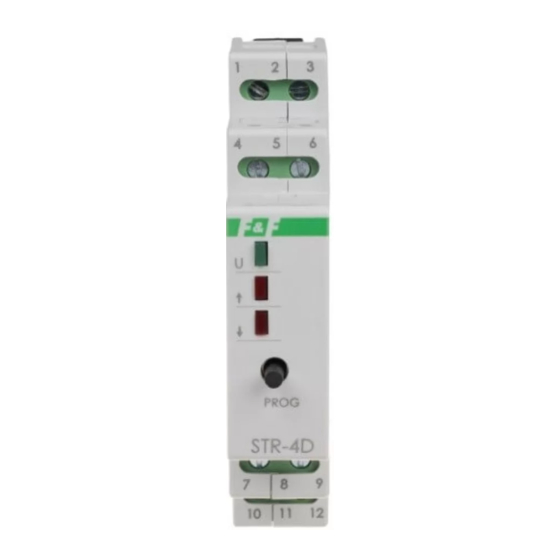
Advertisement
Quick Links
STR-4D
Roller blind controller
for 12/24 V DC
Do not dispose of this device in the trash along with other waste! According
to the Law on Waste, electro coming from households free of charge and
can give any amount to up to that end point of collec� on, as well as to sto-
re the occasion of the purchase of new equipment (in accordance with the
principle of old-for-new, regardless of brand). Electro thrown in the trash or
abandoned in nature, pose a threat to the environment and human health.
Purpose
The STR-4D controller is designed to control roller blinds (���
����) or other objects (e.g. gates) that are driven with DC elec-
tric motor supplied by 12 V or 24 V with momentary switch (eg.
bell).
Functioning
The controller can operate as a stand-alone device (for opening/
closing of a single roller blind), but it is also possible to combine
controllers into groups to control multiple roller blinds. Roller
blind motor starts after momentary passing of the "+" signal to
one of the control inputs. The motor activates for the user-pro-
grammed time that allows to fully lift or lower the roller blind.
Roller blind can be stopped on the user-selected level (incomple-
te opening or closing of the roller blind).
F&F Filipowski sp. j.
Konstantynowska 79/81, 95-200 Pabianice, POLAND
phone/fax (+48 42) 215 23 83 / (+48 42) 227 09 71
www.fif.com.pl; e-mail: biuro@fif.com.pl
- 1 -
Advertisement

Summary of Contents for F&F STR-4D
- Page 1 Purpose The STR-4D controller is designed to control roller blinds (��� ����) or other objects (e.g. gates) that are driven with DC elec- tric motor supplied by 12 V or 24 V with momentary switch (eg.
- Page 2 Control Controller control inputs are divided into two groups: local con- trol and central control. ����� ������� Depending on how you connect the controller, it can operate in one or two local buttons mode. One local button Local control input ���� is connected permanently to the "+" (plus) line.
- Page 3 Memory of direction applies both to local and central control. For example, if the controller carries out a �������-�� command, then the next press of a local button will move the roller blind down. Memory of direction is not retained after a power fa- ilure.
- Page 4 �������-���� button can also close and lock the roller blind in the closed position. If the �������-���� button is pressed and left in the �� position, the controller will close the roller blind and will not allow for its opening until the �������-����...
- Page 5 Scheduling time of activation Time of activation can be programmed upon the assumed time of roller blind operation or by activating the roller blind for the test run. Scheduling for the specified time 1. Press and hold (for approx. 4 s) the ���� button until the green U LED will begin to flash slowly.
- Page 6 If during the first 30 seconds of the learning mode (slow flashing of U LED) the time measuring will not start (the ���� button is pressed or the roller blind is activated from the local control input), the controller will exit the learning mode.
-
Page 7: Connection Diagram
Connection diagram Mode with 1 local button power supply 10÷27 V DC central control – �� ↑↑ direction central control – ���� ↓↓ direction local control – �� ↑ direction local control – ���� ↓ direction motor power supply – terminal A motor power supply –... - Page 8 Mode with 2 local buttons power supply 10÷27 V DC central control – �� ↑↑ direction central control – ���� ↓↓ direction local control – �� ↑ direction local control – ���� ↓ direction motor power supply – terminal A motor power supply –...
-
Page 9: Warranty
Technical data power supply 10÷27 V DC maximum load current (AC-1) power consumption standby 0.15 W 0.6 W control triggered with 10÷27 V DC level switch-on time (adjustable) 1 s÷15 min. power signalling LED green operation and movement direction signalling 2×LED red working temperature -25÷50°C...












Need help?
Do you have a question about the STR-4D and is the answer not in the manual?
Questions and answers